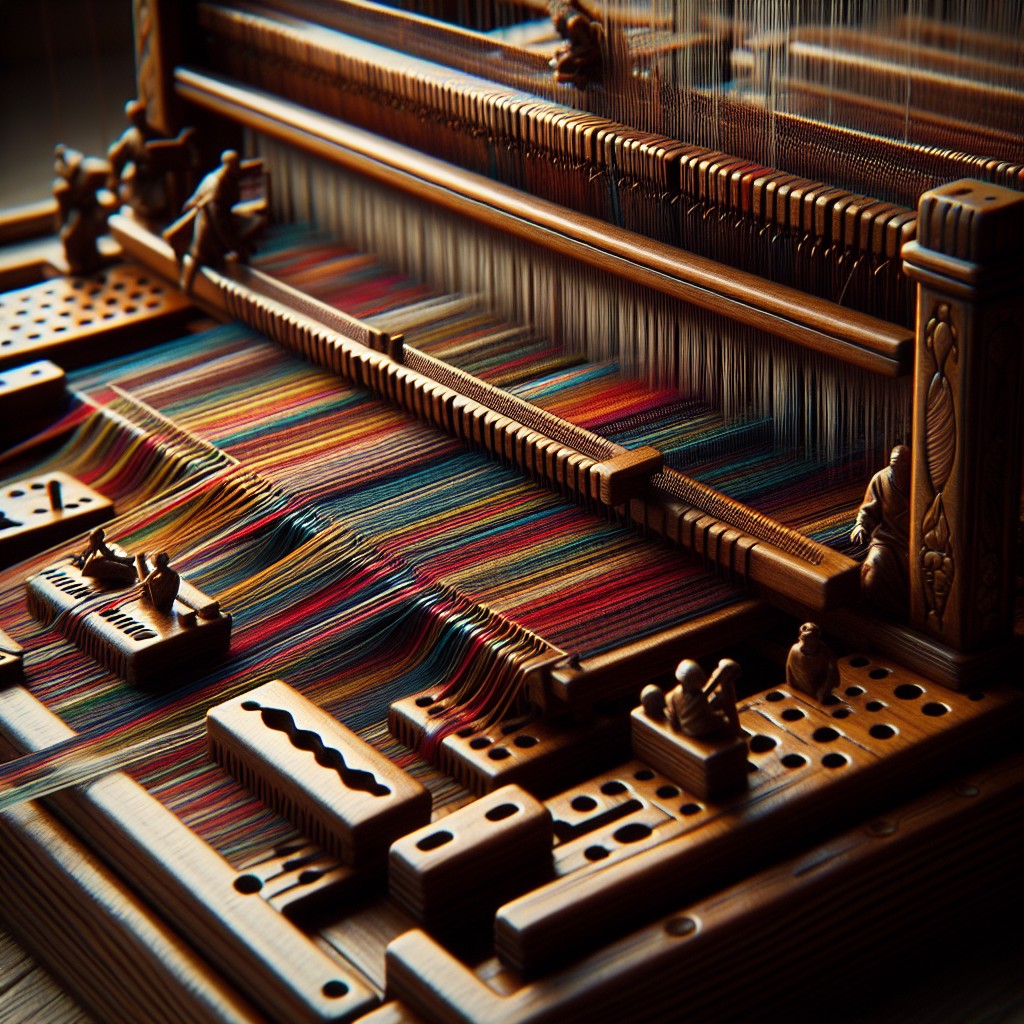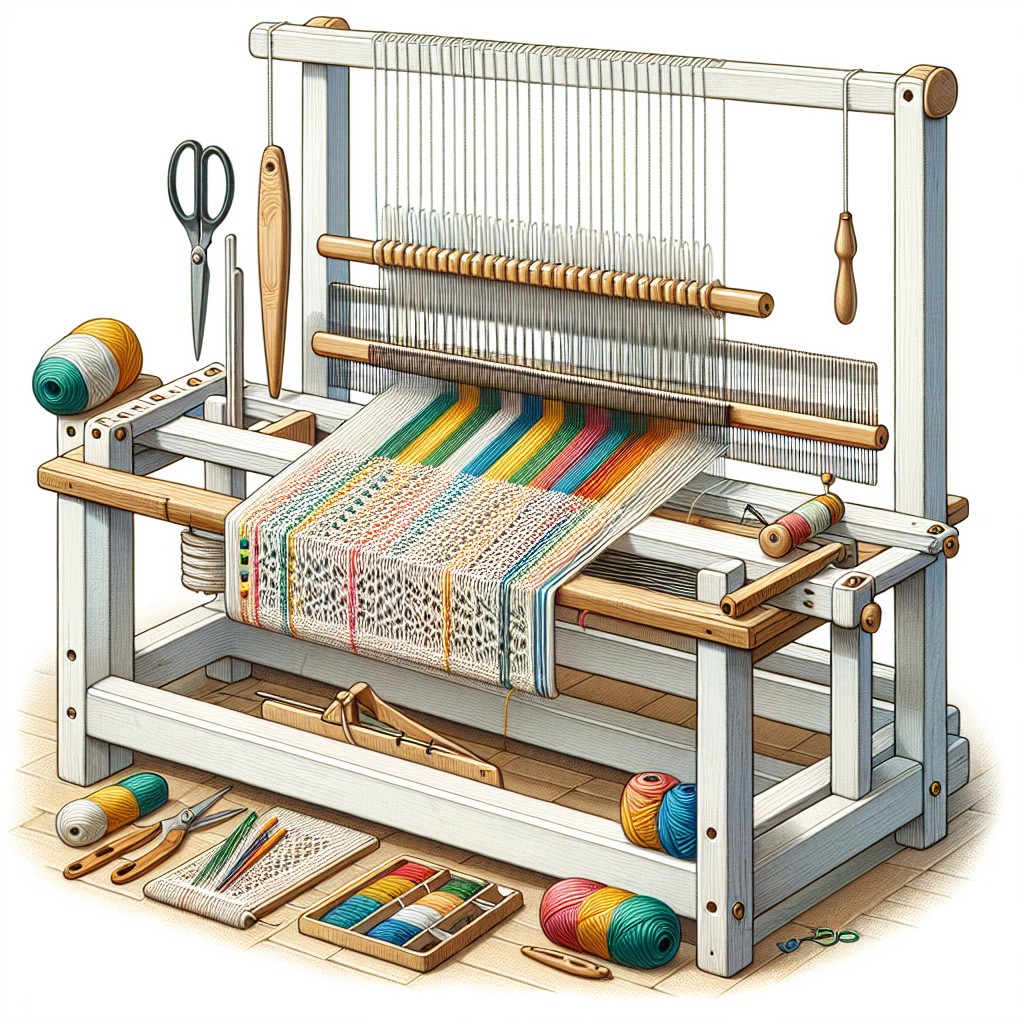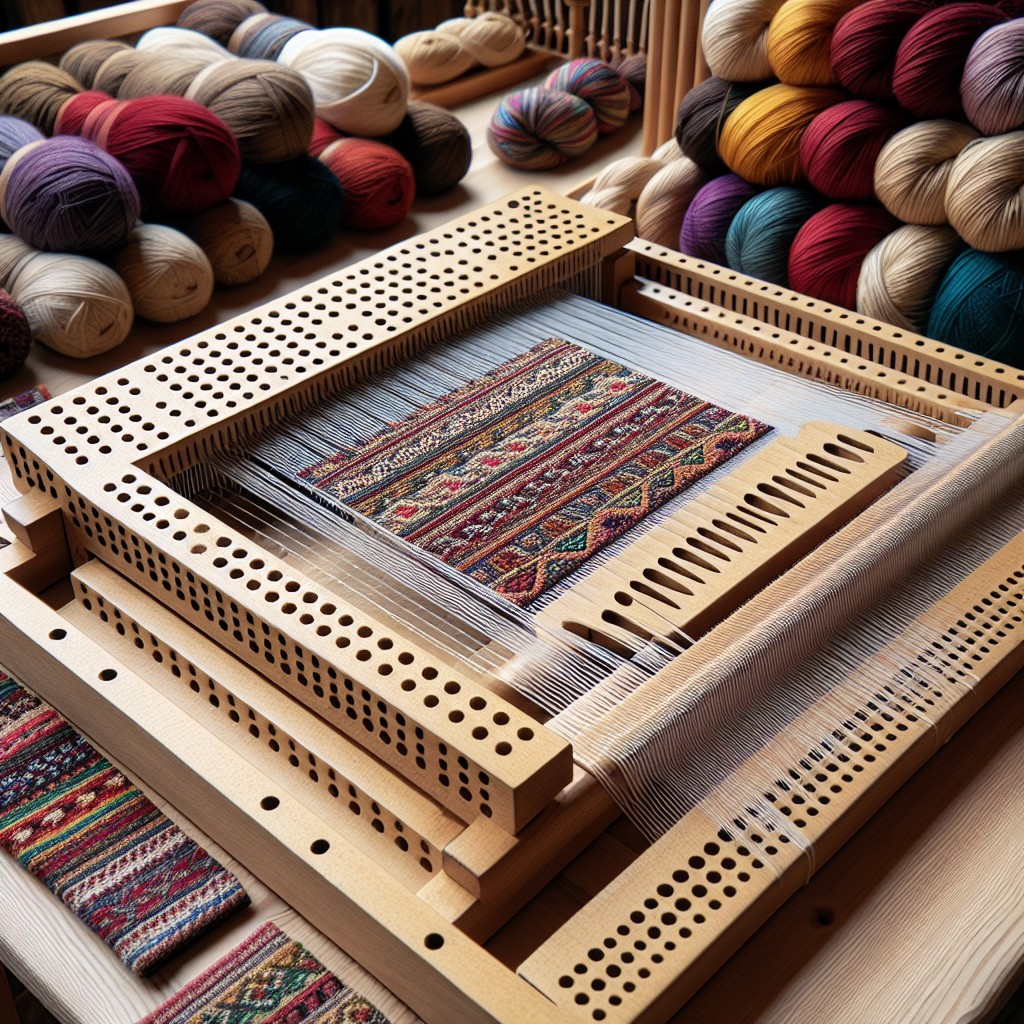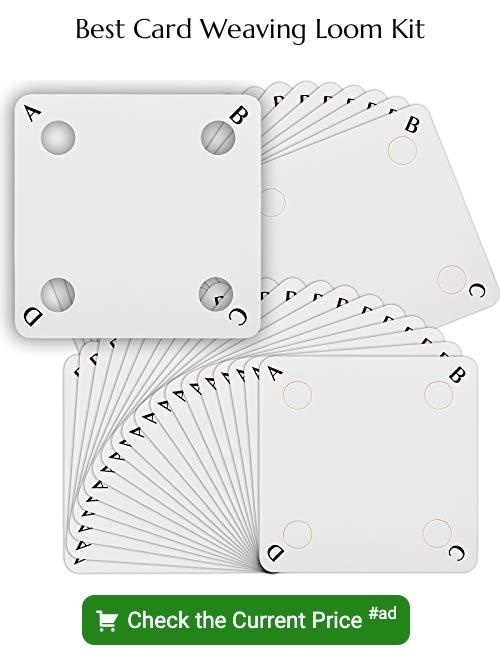Master the craft of card weaving because setting up and using a card weaving loom can unleash a realm of unlimited textile creations.
Key takeaways:
- Card weaving has a rich history dating back to ancient civilizations.
- A card weaving loom consists of cards, warp threads, a weft thread, a shuttle, and a tensioning device.
- Choosing the right yarn is crucial for successful card weaving.
- Setting up the loom involves threading the cards, securing the warp threads, and maintaining tension.
- Card weaving techniques include forward turning, backward turning, combined turns, twining, and picking up patterns.
History and Tradition of Card Weaving

Card weaving, also known as tablet weaving, has a rich tapestry of history dating back to ancient civilizations. Artifacts have been discovered across Europe, the Middle East, and Asia, with evidence suggesting that this technique was known to the Vikings, Egyptians, and even used in medieval times for embellishing clothing.
The craft involves the use of cards or tablets, typically square and with holes at each corner. Historically, materials such as bone, wood, or leather were employed for these cards. The cards serve as guides for the warp threads, controlling the color and design of the weave as they are rotated during the weaving process.
Traditionally, card weaving was utilized to create strong, narrow bands suitable for belts, straps, or decorative trims. The complexity and variety of patterns achievable through the manipulation of these cards are extensive.
This method of weaving is recognized for its portability. Unlike loom-based weaving, card weaving does not require a fixed setup, allowing weavers of the past to carry their craft with them.
Through the centuries, card weaving has been passed down and preserved as a heritage craft, continually evolving with modern interpretations and materials while maintaining the essence of its intricate, interlaced beauty.
Understanding the Card Weaving Loom

A card weaving loom, also known as a tablet weaving loom, operates on a simple yet versatile mechanism. Weavers use cards with holes to manipulate warp threads and create intricate designs. Each card corresponds to one weaving thread, allowing for the control of individual strands.
- The loom typically consists of a series of slots or holes to hold warp threads in place. These threads form the foundation of your work.
- Cards, typically square and made of heavy cardstock, plastic, or wood, are threaded with the warp threads through their four-cornered holes.
- By rotating these cards, you can raise or lower specific warp threads, creating a shed for the weft thread to pass through.
- The simplicity of the setup belies the complexity of patterns possible, including intricate geometric patterns, letters, and images.
- Tension is key; it must be consistent for the warp threads to produce even and tight weaves.
- Unlike other types of looms, the card weaving loom is compact and highly portable, making it a great choice for crafters on the go.
Understanding how the loom functions will enable you to master the basics of card weaving and further explore the craft’s possibilities.
Components of a Card Weaving Loom

A typical card weaving loom setup includes several essential components to facilitate the weaving process:
1. Cards or Tablets: Square or rectangular, with holes at each corner. They control the warp threads, determining the pattern as they’re turned during weaving.
2. Warp Threads: The set of lengthwise fibers held in tension on the loom, which will be interwoven with weft threads to create fabric.
3. Weft Thread: The thread that is woven horizontally, over and under the warp, to build up the textile.
4. Shuttle: A tool used to carry the weft thread across the shed, the temporary separation between upper and lower warp threads.
5. Tensioning Device: This can be a set of dowels, a warp-weighted setup, or a more sophisticated mechanism built into a loom frame; its purpose is to keep consistent tension on the warp threads.
Each of these components comes together to create a functional card weaving loom setup, allowing for the intricate interlacing of threads that this ancient craft is known for. The cards act as the primary mechanism for pattern creation, their rotations interchanging the positions of warp threads in complex sequences that form the desired design.
Selecting the Right Yarn for Card Weaving

Selecting the appropriate yarn is crucial for successful card weaving, as it impacts the durability and appearance of the finished product. Here are essential considerations for choosing yarn:
- Yarn Weight: Opt for a yarn that isn’t too thick or bulky to prevent cards from sticking and jamming. Light to medium-weight yarns are usually most effective.
- Fiber Content: Natural fibers like wool, cotton, and linen offer strength and are traditionally used. Synthetic yarns can also be suitable but ensure they are not too slippery to maintain tension.
- Smoothness: Choose yarns that are smooth and not too fuzzy to allow easy rotation of the cards without snagging.
- Plied Yarns: Multi-plied yarns hold together better during weaving, reducing the likelihood of fraying and breaking.
- Colorfastness: Ensure the yarn’s color will not bleed or fade, which is particularly important when working with multiple colors.
- Texture: Smooth, consistent texture without knots or variegation is recommended for an even weaving process and uniform finish.
Testing a small sample before committing to a large project can help determine if the yarn meets the needs of both the craft and the crafter.
Setting Up the Loom for Card Weaving
Begin by threading each card with the appropriate color yarns as determined by your pattern; each hole in the card corresponds to one thread. Ensure the threads are positioned without twists and lie flat.
Secure one end of the threads to a stationary object, such as a doorknob or a heavy book. This creates tension, which is crucial for the weaving process.
Organize cards in the correct sequence according to the pattern’s instructions. Ensure the orientation of the cards is uniform, with all top-left corners marked similarly to maintain pattern consistency.
Attach the free ends of the yarn to a belt, your waist, or another part of the loom if you’re using one with a built-in tensioning device. Maintain even tension across all threads.
Adjust the tension as needed throughout the setup, confirming that the warp threads remain parallel and appropriately taut, facilitating smooth card rotation during the weaving process.
Verify the setup by gently turning the cards as a group to ensure they move freely and that the threads do not catch or tangle.
Basic Card Weaving Techniques
Card weaving involves manipulating a set of cards with holes punched in the corners to create a wide range of patterns and designs. To begin, each card is threaded with yarn through its four corners. These cards are then rotated to create sheds where the weft can pass through.
Forward Turning:
This is the simplest technique, where all cards are turned in the same direction. As you turn the cards away from you, a pattern begins to emerge on the surface. Consistency is key to maintaining a straight edge.
Backward Turning:
By rotating the cards towards you, patterns are developed in the opposite direction. Backward turning can reverse the appearance of motifs and is often used in combination with forward turning to create complex designs.
Combined Turns:
Combining forward and backward turns can produce intricate designs. Patterns often require specific sequences of turns, sometimes requiring individual cards to move in different directions.
Twining:
Twining involves twisting two or more threads around each other between card turns, adding strength and decorative detail.
Picking Up Patterns:
Advanced card weaving techniques include picking up certain warp threads to create more elaborate designs, disregarding the predetermined threading in favor of a new visual element.
The creation of patterns depends on the sequence and number of turns, which can be followed from a pattern draft or chart. Understanding the relationship between the turning of cards and the resulting weave is fundamental to mastering card weaving.
Reading and Creating Patterns for Card Weaving
The essence of card weaving lies in the patterns that emerge as threads intertwine. Patterns are determined by the order in which the cards are threaded and the sequence of turning the cards during weaving.
To read a pattern, look at the diagram or chart that represents each card’s threading direction (S or Z) and its colored threads. Each column usually represents a card, while each row indicates a turn of all cards in unison.
Creating your own patterns requires understanding the interaction between the warp threads. Here are points to keep in mind:
- Design using graph paper or software to visualize the pattern. Each square on the graph paper can represent a hole in a card.
- Decide on the number of cards and the repeats needed to complete your desired width.
- Experiment with symmetrical designs for an easier understanding of how turning the cards affects the fabric.
- Consider color theory to choose yarns that will highlight the pattern’s geometry.
- Start simple with a few cards to grasp the effect of turning directions on the design before advancing to more complex patterns.
- Remember that the warp-faced fabric will predominantly display warp colors, so choose weft threads that complement rather than compete.
- Test small samples to see how your patterns emerge and make adjustments as needed.
Understanding the logic behind card turns and threadings will unlock an endless variety of patterns for your weaving projects.
Common Projects for Card Weaving
Card weaving is a versatile technique suitable for various items, both functional and decorative. Bracelets and belts are popular beginner projects due to their narrow width and straightforward pattern requirements.
Bookmarks offer a similarly approachable project, allowing for experimentation with different yarns and colors without a large commitment of time or materials.
Advanced weavers may tackle intricacies like guitar straps or intricate trim for clothing and bags, expanding their skill set with more complex patterns.
Table runners and placemats present opportunities to showcase card weaving in home decor, adding a handmade touch to any table setting.
For a blend of durability and design, dog leashes and keychains can be customized with card weaving, resulting in unique and sturdy accessories.
Card weaving can also contribute to larger textile projects, such as weaving bands that are sewn onto fabric to create detailed borders for skirts or jackets.
Troubleshooting Common Card Weaving Issues
Tangled threads can be a frustrating hurdle in card weaving. To resolve tangling, gently separate each strand and use a closed pair of scissors or a blunt needle to guide the threads back into place. Regular pauses to comb out the threads with your fingers can also prevent tangles before they start.
Difficulty turning the cards often indicates excessive tension. Adjust by loosening the warp slightly until the cards can be turned without resistance. However, if the tension is too loose, the shed will not open clearly. Find a balanced tension where the cards turn easily, and the shed is well-defined.
Inconsistent edges, known as ‘draw-in,’ occur when the weft is pulled too tightly. To mitigate this, maintain a consistent weft tension and ‘bubble’ the weft slightly before beating it into place. This ensures enough slack is present to accommodate the draw-in without distorting the edges.
If patterns appear misaligned or distorted, double-check the threading sequence of the cards. Each card should be positioned correctly according to the pattern’s requirements. Mistakes in the initial setup are often to blame for pattern issues, so rectify these early on for error-free weaving.
If the cards become hard to read due to wear or markings rubbing off, consider reinforcing the numbers and letters with permanent ink or replacing the cards altogether. Clear indications on cards are vital for pattern fidelity and trouble-free weaving cycles.
Resources for Card Weaving Enthusiasts
To enhance your card weaving journey, these resources can significantly broaden your knowledge and skills:
- Books: Look for titles such as “Card Weaving” by Candace Crockett and “The Techniques of Tablet Weaving” by Peter Collingwood, which are considered staples in the card weaving community.
- Online Forums: Communities such as Ravelry and Weavolution offer discussions, groups, and forums dedicated to tablet weaving where you can ask questions, share projects, and connect with other weavers.
- Workshops and Classes: Many local yarn stores and community colleges offer workshops on card weaving. Online platforms like Craftsy also provide classes suitable for different skill levels.
- Social Media Groups: Facebook groups and Instagram pages focused on card weaving provide daily inspiration and the opportunity to participate in challenges and collaborations.
- Suppliers: For materials, sites like Etsy and specialty yarn stores often stock a variety of card weaving looms, tablets, and fibers, catering to various needs and preferences.
Remember, engaging with the wider weaving community can provide support and inspiration as you develop your card weaving skills.
FAQ
Can you do card weaving on a rigid heddle loom?
Yes, you can perform card weaving on a rigid heddle loom.
What is a card loom used for?
A card loom, complete with a Jacquard attachment, is used for weaving intricate patterns in materials such as silk, employing punch cards, a precursor to modern computer programming principles.
What are the distinctive features of card weaving compared to other types of weaving?
Card weaving differs from other types of weaving by utilizing square cards with holes at each corner, offering a unique means of color and pattern control.
How can you set up a pattern for card weaving loom?
To set up a pattern for a card weaving loom, thread cards according to desired design, align them in order, then rotate them to create the weave.
What materials are most suitable for card weaving?
Card weaving, also known as tablet weaving, most commonly utilizes materials such as cotton, silk, or wool yarns.





